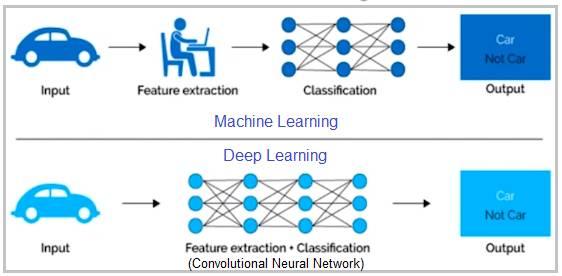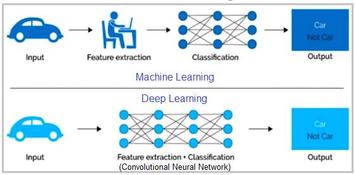5 Advantages and Disadvantages of Deep Learning
Advertisement
Introduction : Machine learning algorithms extract features from images, like corners and edges, to create models of various objects. These models are then used to identify the objects. Traditional machine learning doesn’t always require high performance processors or vast amounts of data. Deep Learning is a subset of machine learning. It’s a technique that learns features and tasks directly from data, whether it’s images, text files, or sound.

Figure-1: Machine Learning Vs Deep Learning
Figure 1 illustrates the processes involved in identifying an object using both machine learning and deep learning. Deep Learning eliminates the need for manual feature extraction; it takes images directly as input. However, it demands high-performance GPUs and a significant amount of data.
Feature extraction and classification are handled by deep learning algorithms, specifically Convolutional Neural Networks (CNNs). CNNs manage both feature extraction and classification based on multiple images. The performance of deep learning algorithms improves with increasing data volume. In contrast, the performance of other learning algorithms may decrease with more data, as shown in Figure 2.

Figure-2: Deep Learning Performance
An artificial neural network contains hidden layers positioned between the input and output layers. Artificial neurons receive weighted inputs and generate an output using an activation function or algorithm. Traditional neural networks contain two or more hidden layers. Deep learning incorporates many such hidden layers (often 150 or more) within the neural network, hence the term “deep.” Figure 3 illustrates this concept.

Figure-3: Number of Hidden Layer
Here are some applications of deep learning that have spurred its development:
- Object Detection/Classification in Photographs
- Self-Driving Cars
- Automated Game Playing
- Automatic Machine Translation
- Colorization of Black & White Images
- Automatic Handwriting Generation
- Image Caption Generation
- Character Text Generation
- Adding Sounds to Silent Movies
- Toxicity Detection for Chemical Structures
- Mitosis Detection from Large Images
- Hallucination/Sequence Generation
- Automated Essay Scoring
Advantages of Deep Learning
The following are benefits of Deep Learning:
- Features are automatically deduced and optimized for the desired outcome. Manual feature extraction is not required, saving time compared to traditional machine learning.
- Robustness to natural variations in data is automatically learned.
- The same neural network-based approach can be applied to various applications and data types.
- Massive parallel computations can be performed using GPUs, scaling effectively for large datasets and delivering better performance with increasing data volumes.
- The deep learning architecture is adaptable to new problems in the future.
Disadvantages of Deep Learning
The following are challenges or limitations of Deep Learning:
- It requires very large amounts of data to outperform other techniques.
- Training is extremely expensive due to complex data models. Deep learning requires expensive GPUs and many machines, increasing costs for users.
- There’s no standard theory for selecting the right deep learning tools, requiring knowledge of topology, training methods, and other parameters. This makes it difficult for less skilled individuals to adopt.
- It’s not easy to comprehend the output based on mere learning, necessitating the use of classifiers like Convolutional Neural Networks to interpret results.
- Deep learning models often act as “black boxes,” offering limited interpretability and explainability, which makes it challenging to understand how specific decisions or predictions are made; especially in critical fields like healthcare or finance.
Conclusion: Deep learning offers remarkable advantages in handling complex tasks like image recognition, natural language processing, and autonomous systems through high accuracy and automation. However, it comes with challenges such as high computational cost, large data requirements, and limited model interpretability, demanding careful implementation and expertise.
Advertisement
 RF
RF

